Training and Development Report: Needs Analysis & Design
VerifiedAdded on 2023/06/10
|15
|3209
|266
Report
AI Summary
This report provides a comprehensive analysis of training and development within a startup care home group. It begins by defining training and development and highlighting the importance of Training Needs Analysis (TNA). The report details the phases of the training cycle and presents a client profile of a care home group seeking to implement TNA. Various TNA tools, such as direct observation, interviews, focus groups, and performance appraisals, are employed to identify skill gaps and training needs within the organization. The analysis reveals the need for a medical manager, updated CRM software, and employee training software. The report then discusses the implementation of effective marketing strategies and addresses issues related to employee turnover and absenteeism. The TNA design approach follows McGhee and Thayer’s three-level analysis, focusing on organizational objectives and outcomes. Ultimately, the report aims to provide recommendations for improving training and development programs within the care home group, enhancing employee skills, and addressing key organizational challenges. Desklib offers a range of similar solved assignments and resources for students.
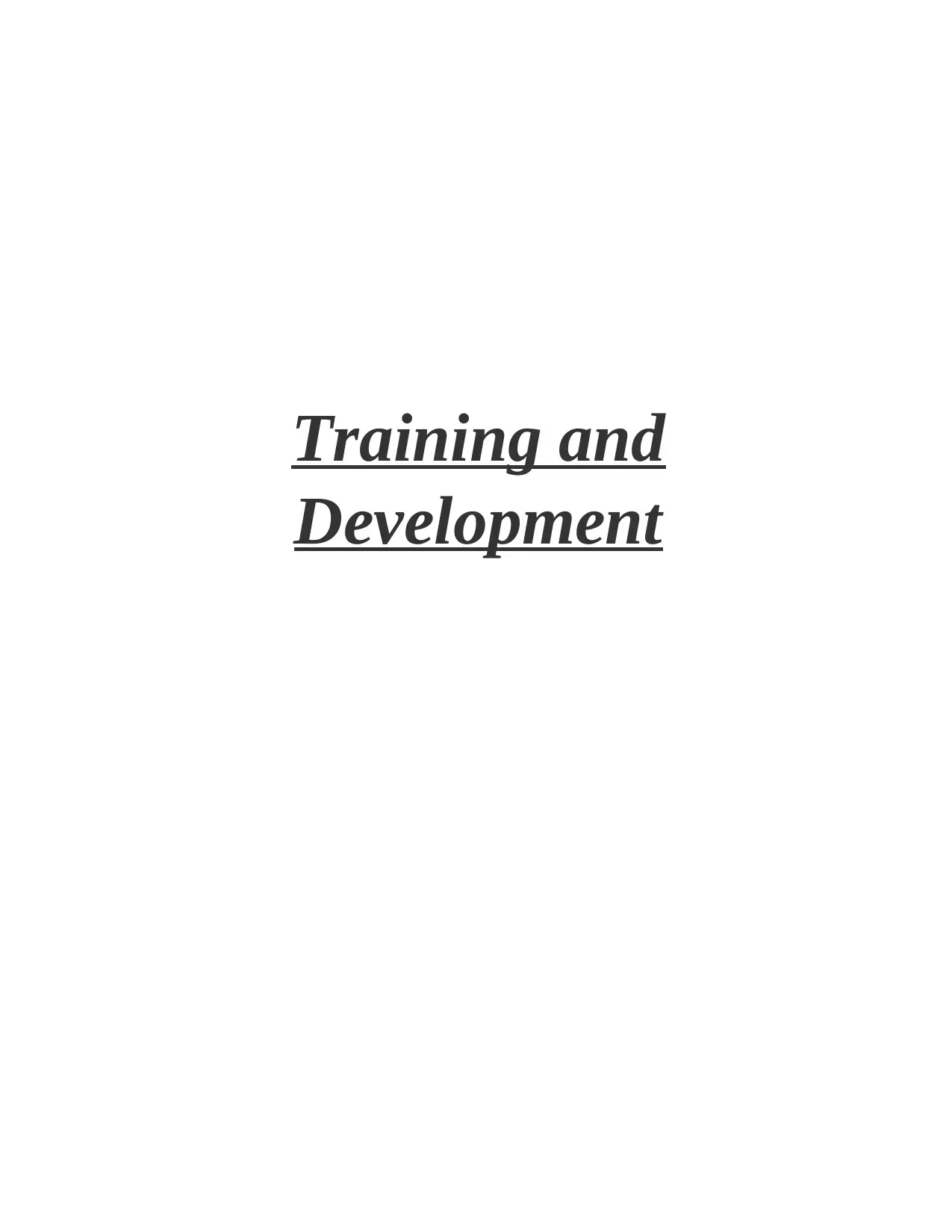
Training and
Development
Development
Paraphrase This Document
Need a fresh take? Get an instant paraphrase of this document with our AI Paraphraser
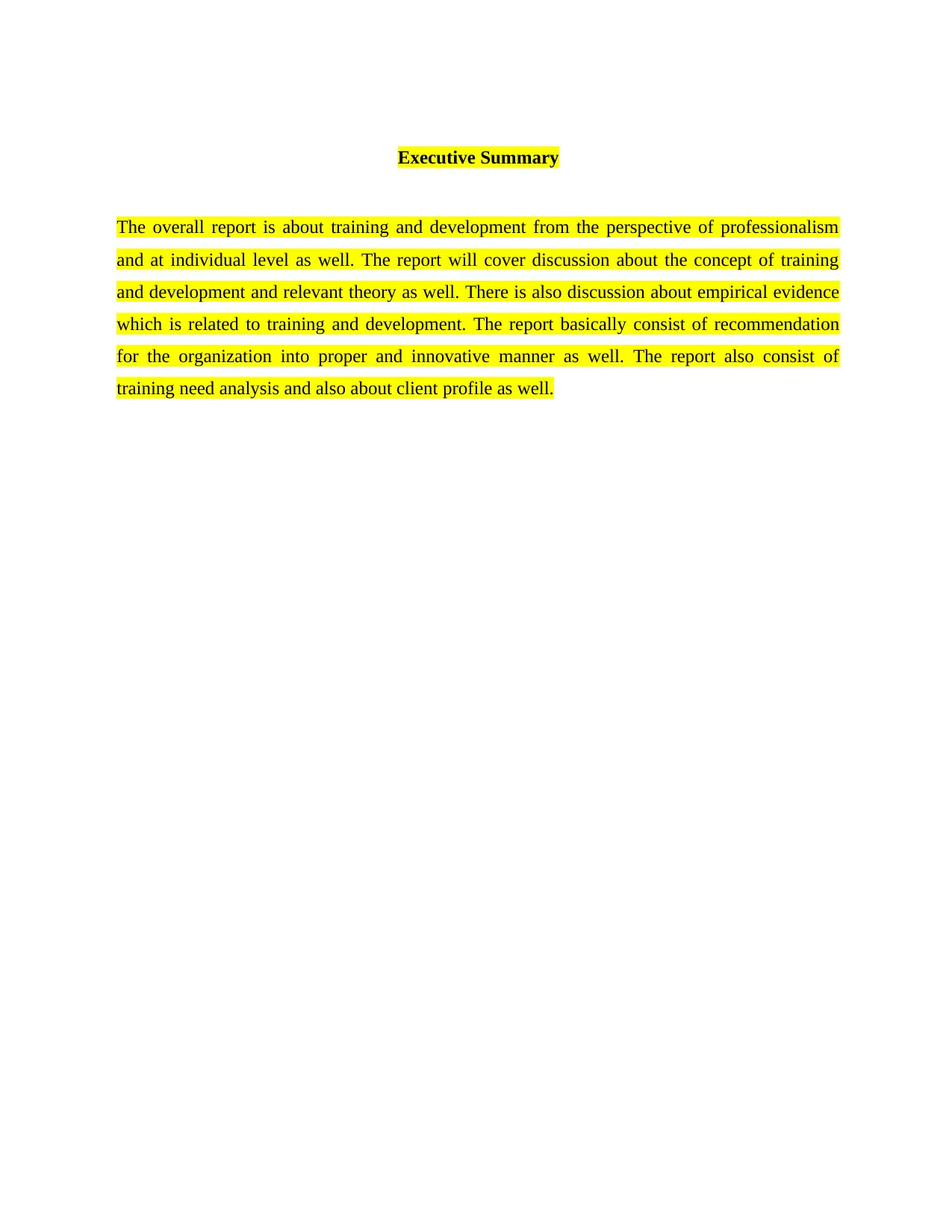
Executive Summary
The overall report is about training and development from the perspective of professionalism
and at individual level as well. The report will cover discussion about the concept of training
and development and relevant theory as well. There is also discussion about empirical evidence
which is related to training and development. The report basically consist of recommendation
for the organization into proper and innovative manner as well. The report also consist of
training need analysis and also about client profile as well.
The overall report is about training and development from the perspective of professionalism
and at individual level as well. The report will cover discussion about the concept of training
and development and relevant theory as well. There is also discussion about empirical evidence
which is related to training and development. The report basically consist of recommendation
for the organization into proper and innovative manner as well. The report also consist of
training need analysis and also about client profile as well.

Table of Contents
INTRODUCTION..........................................................................................................................4
Training Needs Analysis (TNA) or Learning needs analysis (LNA) .......................................4
Phases of training cycle..............................................................................................................5
Client Profile: ............................................................................................................................7
3. Focus group: ..........................................................................................................................9
Evaluation on the basis of McGhee and Thayer’s three level analysis:...................................14
Conclusion/Findings.....................................................................................................................15
INTRODUCTION..........................................................................................................................4
Training Needs Analysis (TNA) or Learning needs analysis (LNA) .......................................4
Phases of training cycle..............................................................................................................5
Client Profile: ............................................................................................................................7
3. Focus group: ..........................................................................................................................9
Evaluation on the basis of McGhee and Thayer’s three level analysis:...................................14
Conclusion/Findings.....................................................................................................................15
⊘ This is a preview!⊘
Do you want full access?
Subscribe today to unlock all pages.

Trusted by 1+ million students worldwide

INTRODUCTION
Training and development basically refers to educational activities at the organizational
level in order to enhance the skills and knowledge of employees while giving instruction and
information on how to better perform the particular tasks(What is training and development ?).
Within the training, the initiative is basically taken by the management with the objective of
meeting out the requirements of an employee(Haugen and et.al., 2019). Under the case of
development, initiative is basically taken by the individual with the objective in order to meet
out the future needs of an employee. In the present report, a client profile is taken into
consideration. It is basically a startup care home groups of twenty care homes launched in late
2017 has thirteen nursing homes and seven residential care homes in and around London. The
present report will cover discussion about the concept of training and development and relevant
theory as well. There is also discussion about empirical evidence which is related to training and
development. The report basically consist of recommendation for the organization into proper
and innovative manner as well.
MAIN BODY
Training Needs Analysis (TNA) or Learning needs analysis (LNA)
It is a business tool that gives people in an organization upskilling and increases
competencies helping the business to transform positively, also it can edge the organization to
stay ahead of the competition. Some say if you skip TNA is equivalent to working on a specific
area blindfolded (Khan and Abdullah., 2019). TNA is a structured process to identify the skill
gaps in employee training and review the state of the organization’s training needs, usually
performed by learning and development consultants. Once you know what is missing you can
outline the priorities and shape your L&D strategy.
Phases of training cycle
The training cycle has basically six stages which include identify training needs, design
training, develop training, delivery training, apply learning and evaluate program as well.
Identify training needs(Stage 1): The first stage in training need cycle is basically
identifying the and assessing the training needs(Cleave.,2020). When legitimate training
Training and development basically refers to educational activities at the organizational
level in order to enhance the skills and knowledge of employees while giving instruction and
information on how to better perform the particular tasks(What is training and development ?).
Within the training, the initiative is basically taken by the management with the objective of
meeting out the requirements of an employee(Haugen and et.al., 2019). Under the case of
development, initiative is basically taken by the individual with the objective in order to meet
out the future needs of an employee. In the present report, a client profile is taken into
consideration. It is basically a startup care home groups of twenty care homes launched in late
2017 has thirteen nursing homes and seven residential care homes in and around London. The
present report will cover discussion about the concept of training and development and relevant
theory as well. There is also discussion about empirical evidence which is related to training and
development. The report basically consist of recommendation for the organization into proper
and innovative manner as well.
MAIN BODY
Training Needs Analysis (TNA) or Learning needs analysis (LNA)
It is a business tool that gives people in an organization upskilling and increases
competencies helping the business to transform positively, also it can edge the organization to
stay ahead of the competition. Some say if you skip TNA is equivalent to working on a specific
area blindfolded (Khan and Abdullah., 2019). TNA is a structured process to identify the skill
gaps in employee training and review the state of the organization’s training needs, usually
performed by learning and development consultants. Once you know what is missing you can
outline the priorities and shape your L&D strategy.
Phases of training cycle
The training cycle has basically six stages which include identify training needs, design
training, develop training, delivery training, apply learning and evaluate program as well.
Identify training needs(Stage 1): The first stage in training need cycle is basically
identifying the and assessing the training needs(Cleave.,2020). When legitimate training
Paraphrase This Document
Need a fresh take? Get an instant paraphrase of this document with our AI Paraphraser
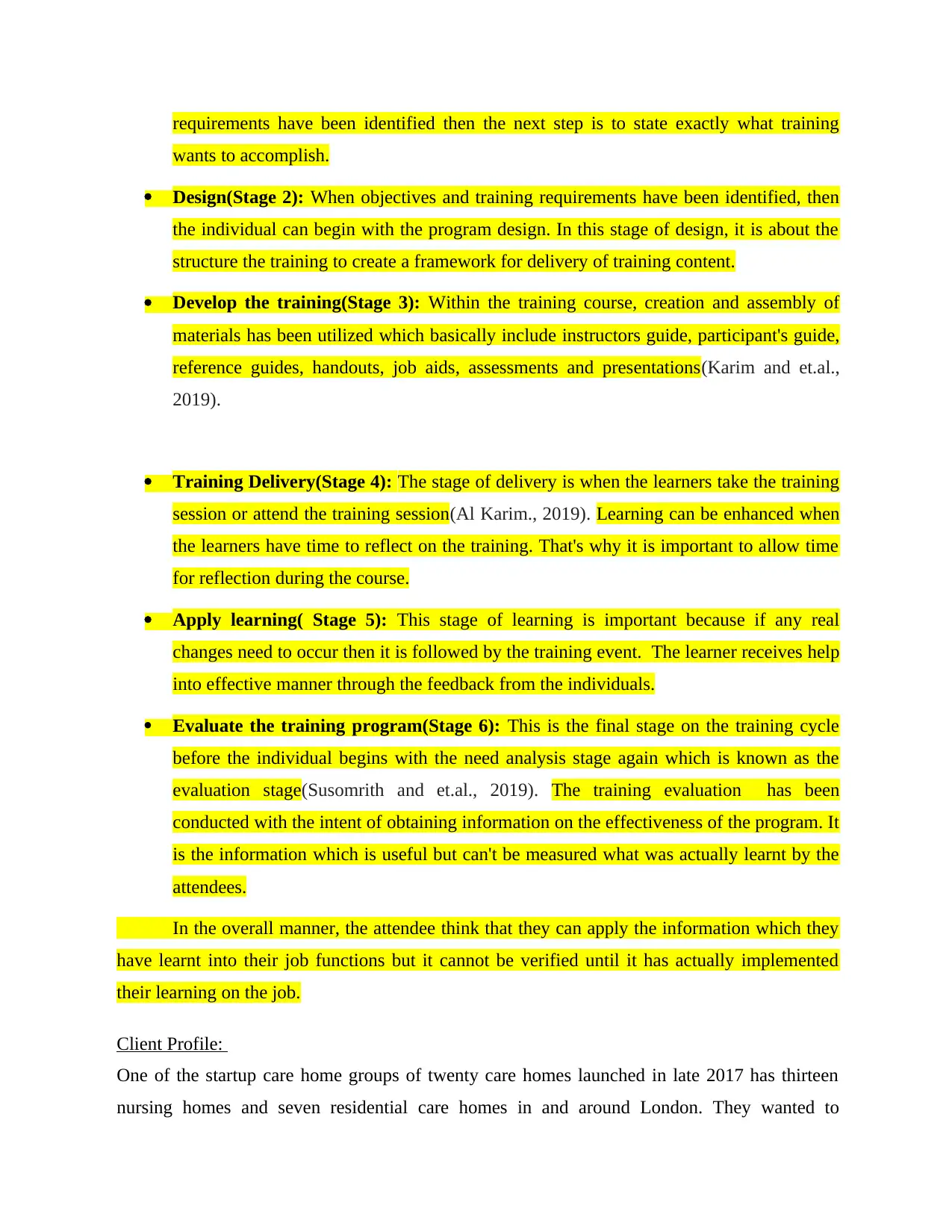
requirements have been identified then the next step is to state exactly what training
wants to accomplish.
Design(Stage 2): When objectives and training requirements have been identified, then
the individual can begin with the program design. In this stage of design, it is about the
structure the training to create a framework for delivery of training content.
Develop the training(Stage 3): Within the training course, creation and assembly of
materials has been utilized which basically include instructors guide, participant's guide,
reference guides, handouts, job aids, assessments and presentations(Karim and et.al.,
2019).
Training Delivery(Stage 4): The stage of delivery is when the learners take the training
session or attend the training session(Al Karim., 2019). Learning can be enhanced when
the learners have time to reflect on the training. That's why it is important to allow time
for reflection during the course.
Apply learning( Stage 5): This stage of learning is important because if any real
changes need to occur then it is followed by the training event. The learner receives help
into effective manner through the feedback from the individuals.
Evaluate the training program(Stage 6): This is the final stage on the training cycle
before the individual begins with the need analysis stage again which is known as the
evaluation stage(Susomrith and et.al., 2019). The training evaluation has been
conducted with the intent of obtaining information on the effectiveness of the program. It
is the information which is useful but can't be measured what was actually learnt by the
attendees.
In the overall manner, the attendee think that they can apply the information which they
have learnt into their job functions but it cannot be verified until it has actually implemented
their learning on the job.
Client Profile:
One of the startup care home groups of twenty care homes launched in late 2017 has thirteen
nursing homes and seven residential care homes in and around London. They wanted to
wants to accomplish.
Design(Stage 2): When objectives and training requirements have been identified, then
the individual can begin with the program design. In this stage of design, it is about the
structure the training to create a framework for delivery of training content.
Develop the training(Stage 3): Within the training course, creation and assembly of
materials has been utilized which basically include instructors guide, participant's guide,
reference guides, handouts, job aids, assessments and presentations(Karim and et.al.,
2019).
Training Delivery(Stage 4): The stage of delivery is when the learners take the training
session or attend the training session(Al Karim., 2019). Learning can be enhanced when
the learners have time to reflect on the training. That's why it is important to allow time
for reflection during the course.
Apply learning( Stage 5): This stage of learning is important because if any real
changes need to occur then it is followed by the training event. The learner receives help
into effective manner through the feedback from the individuals.
Evaluate the training program(Stage 6): This is the final stage on the training cycle
before the individual begins with the need analysis stage again which is known as the
evaluation stage(Susomrith and et.al., 2019). The training evaluation has been
conducted with the intent of obtaining information on the effectiveness of the program. It
is the information which is useful but can't be measured what was actually learnt by the
attendees.
In the overall manner, the attendee think that they can apply the information which they
have learnt into their job functions but it cannot be verified until it has actually implemented
their learning on the job.
Client Profile:
One of the startup care home groups of twenty care homes launched in late 2017 has thirteen
nursing homes and seven residential care homes in and around London. They wanted to

implement TNA for their corporate office (head office staff-HOS) to identify, a) if they are
meeting their performance targets b) are there any new laws and regulations beneficial for the
team c) do people need to work with new technology d) do they need to learn to work within
different resource constraints, e) do they need to address human resource issues like job
turnover, absenteeism and recruitment problems, among fourteen staff working in the head
office as well as in their care homes, within a timescale of six to seven months(Maity., 2019).
Whilst taking an audit of checking company's head office employee skill status using different
TNA tools like,
1. Direct observation (DO): DO here was overt as the individuals in the environment knew the
purpose of the observation and observing a bunch of people, but since it was structured DO for
only certain information gathering it seemed standard here.
2. Interviews: to clarify roles and responsibilities of each staff, solicited for the org chart or
organogram that represents people and position in the company, that kept an understanding of
the company hierarchy.
Out of speculation made an understanding of the highest level of education of each team
member and the number of years of experience they have in the company which is imperative.
Some open-ended TNA questions for each staff were given like,
What would you think will be the top three priority topics for employee training and
development this year?
What improvements overall could be made to deliver the training program?
What training have you or your team benefited from in the past and why?
What are some of the barriers you face when it comes to participating in a training
program?
What challenges do you face that could be resolved with training?
Is there a way we can make the courses and workshops more accessible to you and your
team?
meeting their performance targets b) are there any new laws and regulations beneficial for the
team c) do people need to work with new technology d) do they need to learn to work within
different resource constraints, e) do they need to address human resource issues like job
turnover, absenteeism and recruitment problems, among fourteen staff working in the head
office as well as in their care homes, within a timescale of six to seven months(Maity., 2019).
Whilst taking an audit of checking company's head office employee skill status using different
TNA tools like,
1. Direct observation (DO): DO here was overt as the individuals in the environment knew the
purpose of the observation and observing a bunch of people, but since it was structured DO for
only certain information gathering it seemed standard here.
2. Interviews: to clarify roles and responsibilities of each staff, solicited for the org chart or
organogram that represents people and position in the company, that kept an understanding of
the company hierarchy.
Out of speculation made an understanding of the highest level of education of each team
member and the number of years of experience they have in the company which is imperative.
Some open-ended TNA questions for each staff were given like,
What would you think will be the top three priority topics for employee training and
development this year?
What improvements overall could be made to deliver the training program?
What training have you or your team benefited from in the past and why?
What are some of the barriers you face when it comes to participating in a training
program?
What challenges do you face that could be resolved with training?
Is there a way we can make the courses and workshops more accessible to you and your
team?
⊘ This is a preview!⊘
Do you want full access?
Subscribe today to unlock all pages.

Trusted by 1+ million students worldwide
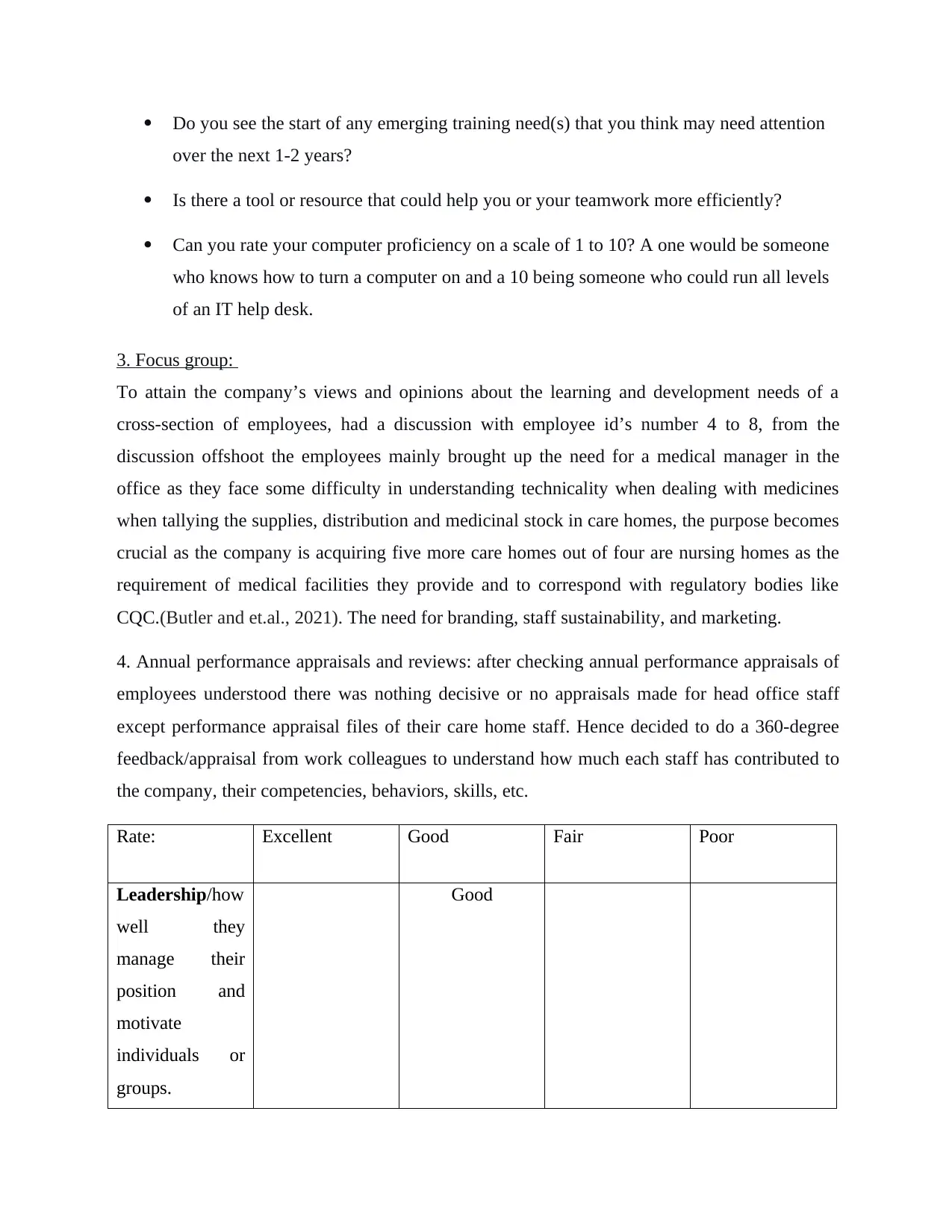
Do you see the start of any emerging training need(s) that you think may need attention
over the next 1-2 years?
Is there a tool or resource that could help you or your teamwork more efficiently?
Can you rate your computer proficiency on a scale of 1 to 10? A one would be someone
who knows how to turn a computer on and a 10 being someone who could run all levels
of an IT help desk.
3. Focus group:
To attain the company’s views and opinions about the learning and development needs of a
cross-section of employees, had a discussion with employee id’s number 4 to 8, from the
discussion offshoot the employees mainly brought up the need for a medical manager in the
office as they face some difficulty in understanding technicality when dealing with medicines
when tallying the supplies, distribution and medicinal stock in care homes, the purpose becomes
crucial as the company is acquiring five more care homes out of four are nursing homes as the
requirement of medical facilities they provide and to correspond with regulatory bodies like
CQC.(Butler and et.al., 2021). The need for branding, staff sustainability, and marketing.
4. Annual performance appraisals and reviews: after checking annual performance appraisals of
employees understood there was nothing decisive or no appraisals made for head office staff
except performance appraisal files of their care home staff. Hence decided to do a 360-degree
feedback/appraisal from work colleagues to understand how much each staff has contributed to
the company, their competencies, behaviors, skills, etc.
Rate: Excellent Good Fair Poor
Leadership/how
well they
manage their
position and
motivate
individuals or
groups.
Good
over the next 1-2 years?
Is there a tool or resource that could help you or your teamwork more efficiently?
Can you rate your computer proficiency on a scale of 1 to 10? A one would be someone
who knows how to turn a computer on and a 10 being someone who could run all levels
of an IT help desk.
3. Focus group:
To attain the company’s views and opinions about the learning and development needs of a
cross-section of employees, had a discussion with employee id’s number 4 to 8, from the
discussion offshoot the employees mainly brought up the need for a medical manager in the
office as they face some difficulty in understanding technicality when dealing with medicines
when tallying the supplies, distribution and medicinal stock in care homes, the purpose becomes
crucial as the company is acquiring five more care homes out of four are nursing homes as the
requirement of medical facilities they provide and to correspond with regulatory bodies like
CQC.(Butler and et.al., 2021). The need for branding, staff sustainability, and marketing.
4. Annual performance appraisals and reviews: after checking annual performance appraisals of
employees understood there was nothing decisive or no appraisals made for head office staff
except performance appraisal files of their care home staff. Hence decided to do a 360-degree
feedback/appraisal from work colleagues to understand how much each staff has contributed to
the company, their competencies, behaviors, skills, etc.
Rate: Excellent Good Fair Poor
Leadership/how
well they
manage their
position and
motivate
individuals or
groups.
Good
Paraphrase This Document
Need a fresh take? Get an instant paraphrase of this document with our AI Paraphraser
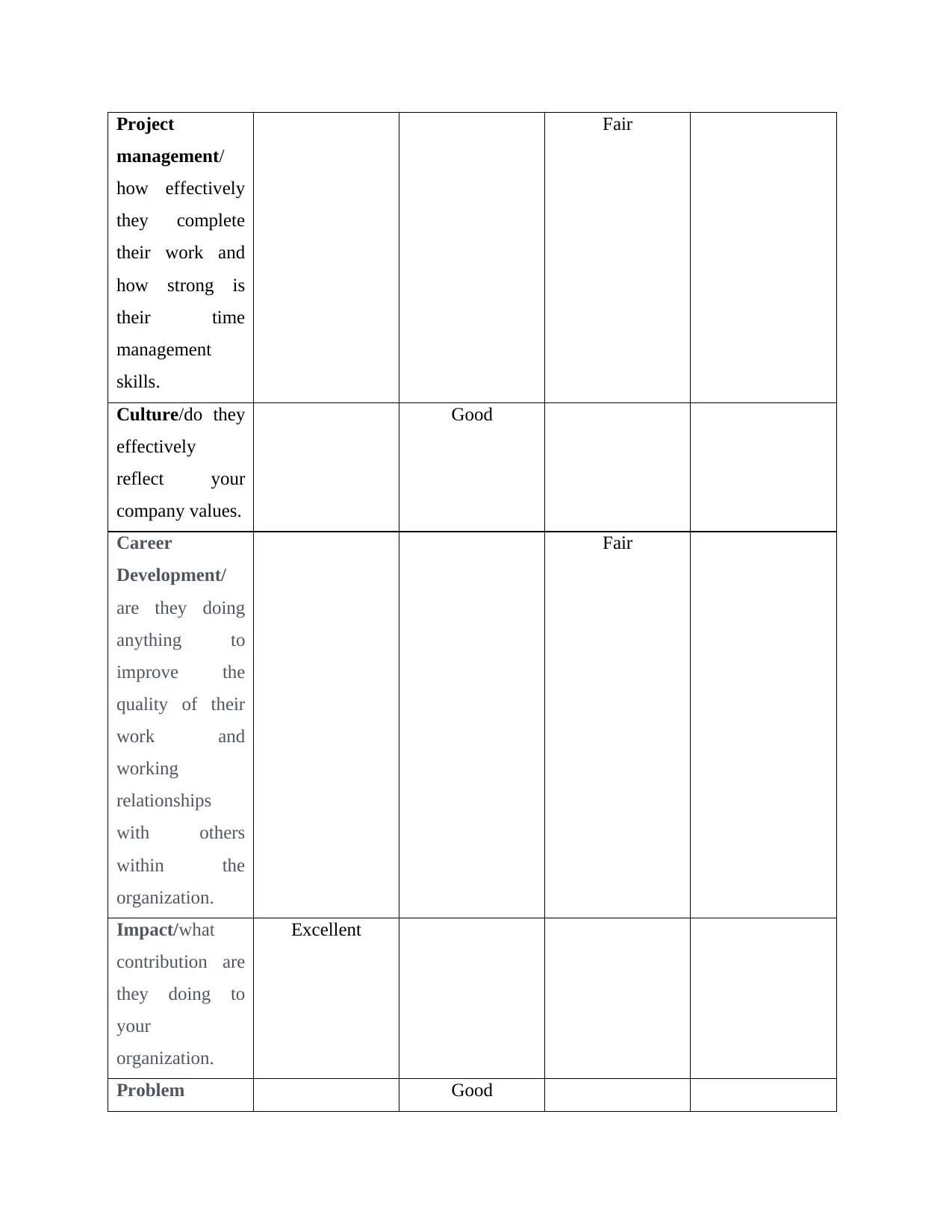
Project
management/
how effectively
they complete
their work and
how strong is
their time
management
skills.
Fair
Culture/do they
effectively
reflect your
company values.
Good
Career
Development/
are they doing
anything to
improve the
quality of their
work and
working
relationships
with others
within the
organization.
Fair
Impact/what
contribution are
they doing to
your
organization.
Excellent
Problem Good
management/
how effectively
they complete
their work and
how strong is
their time
management
skills.
Fair
Culture/do they
effectively
reflect your
company values.
Good
Career
Development/
are they doing
anything to
improve the
quality of their
work and
working
relationships
with others
within the
organization.
Fair
Impact/what
contribution are
they doing to
your
organization.
Excellent
Problem Good

Solving/How
well they
approach
challenges? Do
they employ
creative ideas to
solving
problems.
Communication
Skills/How well
they interact
with co-
workers? Do
they have a
positive attitude,
or are they
always making
negative
comments?
Fair
The above questionnaire form was provided to all HOS to assess each staff except the
executives. From employee ID3 to ID14 was assessed, so each person gets 11 assessment forms
(Miller and Akdere.,2019). No staff was marked poor and no staff secured excellent remarks
from staff colleagues except ID8 obtained excellent in project management and one staff gave
ID8 excellent in communication.
5.Product from SWOT analysis:
6. Work samples: on observing on staff's working pattern, all were meeting the purpose of their
job but no specific goal or timescale/deadline given or expected from the staff, except for some
employees who deal with company finance and payroll.
Found, the learning function should focus, a) attract and retain staff b) motivate and engage staff
c) build a brand or promotions /PR and marketing work d) value-based working culture e)
well they
approach
challenges? Do
they employ
creative ideas to
solving
problems.
Communication
Skills/How well
they interact
with co-
workers? Do
they have a
positive attitude,
or are they
always making
negative
comments?
Fair
The above questionnaire form was provided to all HOS to assess each staff except the
executives. From employee ID3 to ID14 was assessed, so each person gets 11 assessment forms
(Miller and Akdere.,2019). No staff was marked poor and no staff secured excellent remarks
from staff colleagues except ID8 obtained excellent in project management and one staff gave
ID8 excellent in communication.
5.Product from SWOT analysis:
6. Work samples: on observing on staff's working pattern, all were meeting the purpose of their
job but no specific goal or timescale/deadline given or expected from the staff, except for some
employees who deal with company finance and payroll.
Found, the learning function should focus, a) attract and retain staff b) motivate and engage staff
c) build a brand or promotions /PR and marketing work d) value-based working culture e)
⊘ This is a preview!⊘
Do you want full access?
Subscribe today to unlock all pages.

Trusted by 1+ million students worldwide
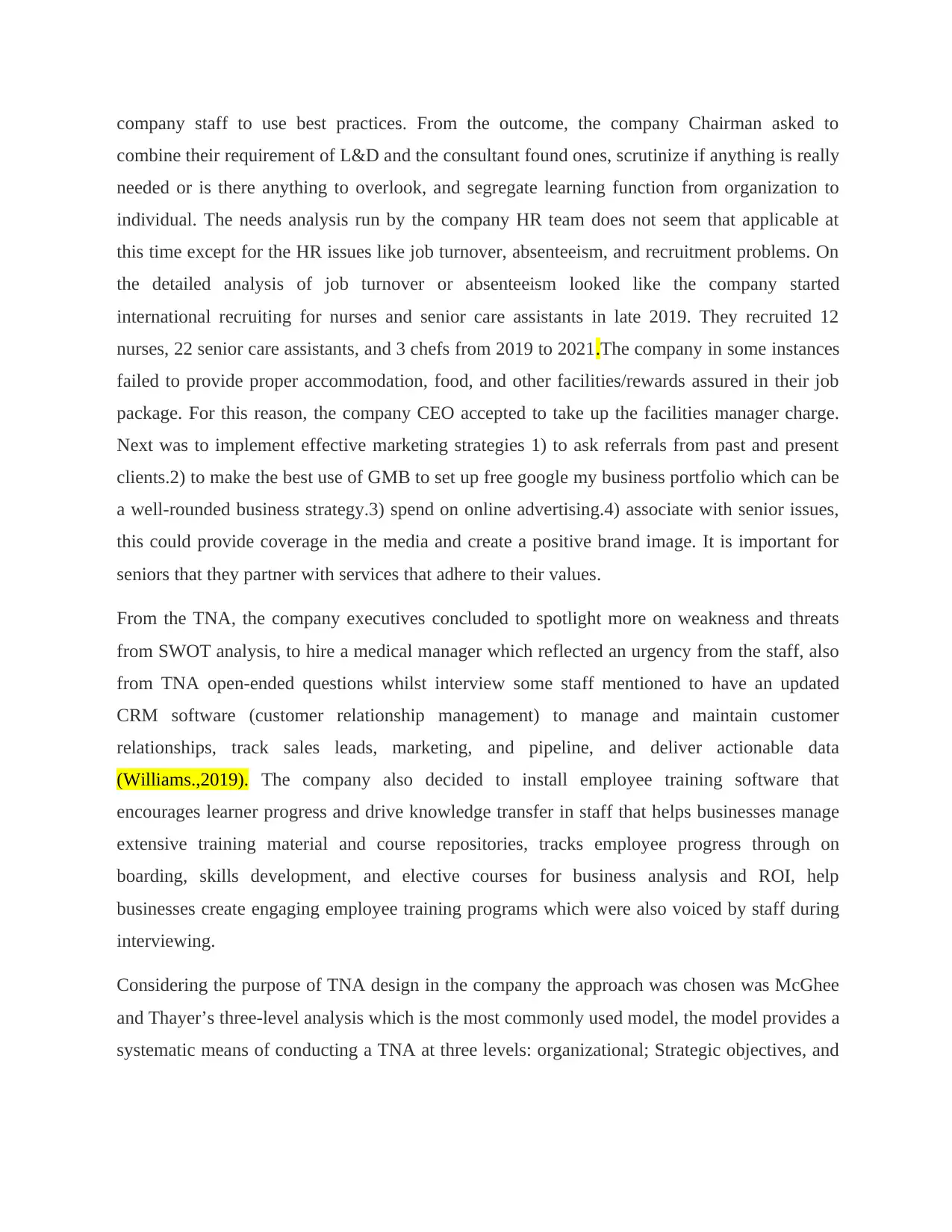
company staff to use best practices. From the outcome, the company Chairman asked to
combine their requirement of L&D and the consultant found ones, scrutinize if anything is really
needed or is there anything to overlook, and segregate learning function from organization to
individual. The needs analysis run by the company HR team does not seem that applicable at
this time except for the HR issues like job turnover, absenteeism, and recruitment problems. On
the detailed analysis of job turnover or absenteeism looked like the company started
international recruiting for nurses and senior care assistants in late 2019. They recruited 12
nurses, 22 senior care assistants, and 3 chefs from 2019 to 2021.The company in some instances
failed to provide proper accommodation, food, and other facilities/rewards assured in their job
package. For this reason, the company CEO accepted to take up the facilities manager charge.
Next was to implement effective marketing strategies 1) to ask referrals from past and present
clients.2) to make the best use of GMB to set up free google my business portfolio which can be
a well-rounded business strategy.3) spend on online advertising.4) associate with senior issues,
this could provide coverage in the media and create a positive brand image. It is important for
seniors that they partner with services that adhere to their values.
From the TNA, the company executives concluded to spotlight more on weakness and threats
from SWOT analysis, to hire a medical manager which reflected an urgency from the staff, also
from TNA open-ended questions whilst interview some staff mentioned to have an updated
CRM software (customer relationship management) to manage and maintain customer
relationships, track sales leads, marketing, and pipeline, and deliver actionable data
(Williams.,2019). The company also decided to install employee training software that
encourages learner progress and drive knowledge transfer in staff that helps businesses manage
extensive training material and course repositories, tracks employee progress through on
boarding, skills development, and elective courses for business analysis and ROI, help
businesses create engaging employee training programs which were also voiced by staff during
interviewing.
Considering the purpose of TNA design in the company the approach was chosen was McGhee
and Thayer’s three-level analysis which is the most commonly used model, the model provides a
systematic means of conducting a TNA at three levels: organizational; Strategic objectives, and
combine their requirement of L&D and the consultant found ones, scrutinize if anything is really
needed or is there anything to overlook, and segregate learning function from organization to
individual. The needs analysis run by the company HR team does not seem that applicable at
this time except for the HR issues like job turnover, absenteeism, and recruitment problems. On
the detailed analysis of job turnover or absenteeism looked like the company started
international recruiting for nurses and senior care assistants in late 2019. They recruited 12
nurses, 22 senior care assistants, and 3 chefs from 2019 to 2021.The company in some instances
failed to provide proper accommodation, food, and other facilities/rewards assured in their job
package. For this reason, the company CEO accepted to take up the facilities manager charge.
Next was to implement effective marketing strategies 1) to ask referrals from past and present
clients.2) to make the best use of GMB to set up free google my business portfolio which can be
a well-rounded business strategy.3) spend on online advertising.4) associate with senior issues,
this could provide coverage in the media and create a positive brand image. It is important for
seniors that they partner with services that adhere to their values.
From the TNA, the company executives concluded to spotlight more on weakness and threats
from SWOT analysis, to hire a medical manager which reflected an urgency from the staff, also
from TNA open-ended questions whilst interview some staff mentioned to have an updated
CRM software (customer relationship management) to manage and maintain customer
relationships, track sales leads, marketing, and pipeline, and deliver actionable data
(Williams.,2019). The company also decided to install employee training software that
encourages learner progress and drive knowledge transfer in staff that helps businesses manage
extensive training material and course repositories, tracks employee progress through on
boarding, skills development, and elective courses for business analysis and ROI, help
businesses create engaging employee training programs which were also voiced by staff during
interviewing.
Considering the purpose of TNA design in the company the approach was chosen was McGhee
and Thayer’s three-level analysis which is the most commonly used model, the model provides a
systematic means of conducting a TNA at three levels: organizational; Strategic objectives, and
Paraphrase This Document
Need a fresh take? Get an instant paraphrase of this document with our AI Paraphraser
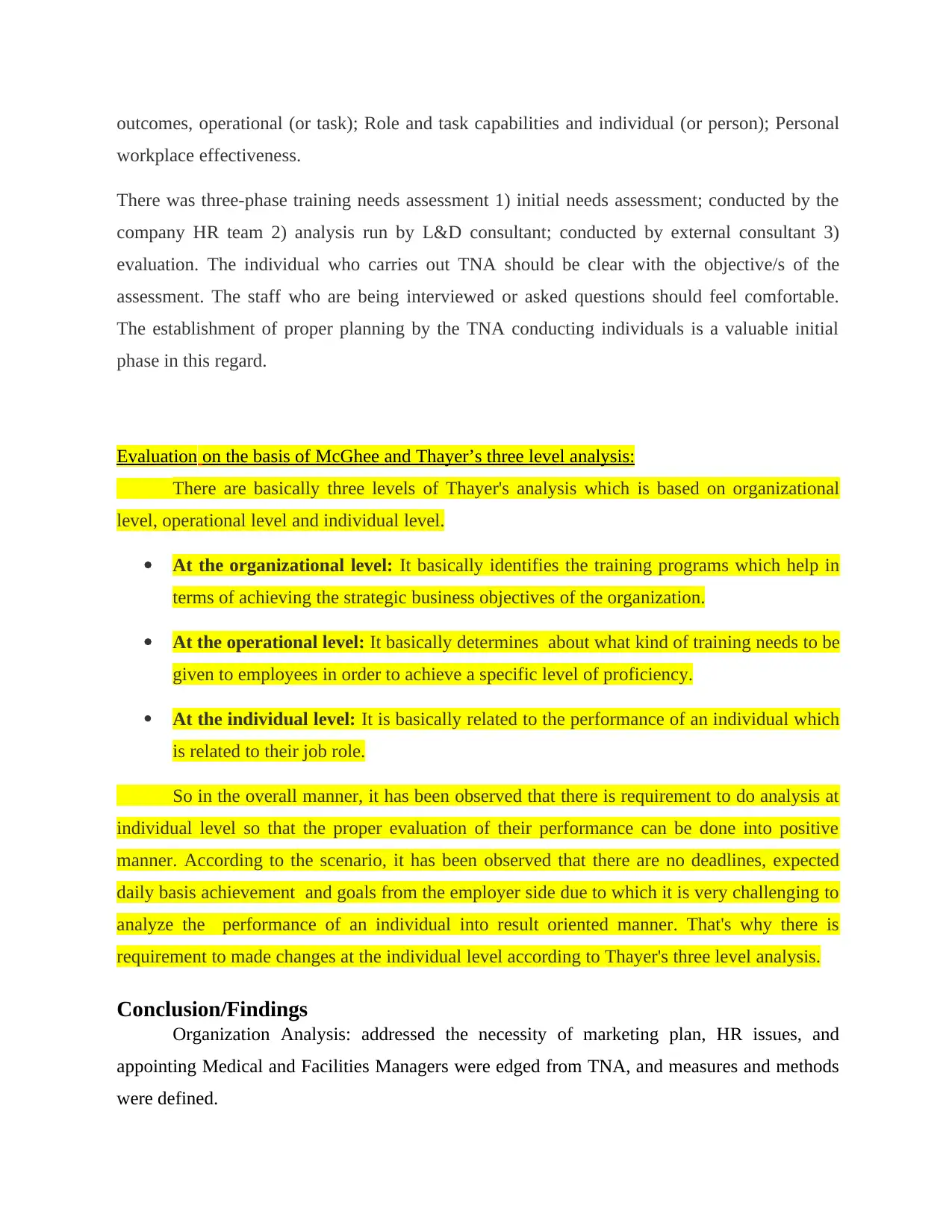
outcomes, operational (or task); Role and task capabilities and individual (or person); Personal
workplace effectiveness.
There was three-phase training needs assessment 1) initial needs assessment; conducted by the
company HR team 2) analysis run by L&D consultant; conducted by external consultant 3)
evaluation. The individual who carries out TNA should be clear with the objective/s of the
assessment. The staff who are being interviewed or asked questions should feel comfortable.
The establishment of proper planning by the TNA conducting individuals is a valuable initial
phase in this regard.
Evaluation on the basis of McGhee and Thayer’s three level analysis:
There are basically three levels of Thayer's analysis which is based on organizational
level, operational level and individual level.
At the organizational level: It basically identifies the training programs which help in
terms of achieving the strategic business objectives of the organization.
At the operational level: It basically determines about what kind of training needs to be
given to employees in order to achieve a specific level of proficiency.
At the individual level: It is basically related to the performance of an individual which
is related to their job role.
So in the overall manner, it has been observed that there is requirement to do analysis at
individual level so that the proper evaluation of their performance can be done into positive
manner. According to the scenario, it has been observed that there are no deadlines, expected
daily basis achievement and goals from the employer side due to which it is very challenging to
analyze the performance of an individual into result oriented manner. That's why there is
requirement to made changes at the individual level according to Thayer's three level analysis.
Conclusion/Findings
Organization Analysis: addressed the necessity of marketing plan, HR issues, and
appointing Medical and Facilities Managers were edged from TNA, and measures and methods
were defined.
workplace effectiveness.
There was three-phase training needs assessment 1) initial needs assessment; conducted by the
company HR team 2) analysis run by L&D consultant; conducted by external consultant 3)
evaluation. The individual who carries out TNA should be clear with the objective/s of the
assessment. The staff who are being interviewed or asked questions should feel comfortable.
The establishment of proper planning by the TNA conducting individuals is a valuable initial
phase in this regard.
Evaluation on the basis of McGhee and Thayer’s three level analysis:
There are basically three levels of Thayer's analysis which is based on organizational
level, operational level and individual level.
At the organizational level: It basically identifies the training programs which help in
terms of achieving the strategic business objectives of the organization.
At the operational level: It basically determines about what kind of training needs to be
given to employees in order to achieve a specific level of proficiency.
At the individual level: It is basically related to the performance of an individual which
is related to their job role.
So in the overall manner, it has been observed that there is requirement to do analysis at
individual level so that the proper evaluation of their performance can be done into positive
manner. According to the scenario, it has been observed that there are no deadlines, expected
daily basis achievement and goals from the employer side due to which it is very challenging to
analyze the performance of an individual into result oriented manner. That's why there is
requirement to made changes at the individual level according to Thayer's three level analysis.
Conclusion/Findings
Organization Analysis: addressed the necessity of marketing plan, HR issues, and
appointing Medical and Facilities Managers were edged from TNA, and measures and methods
were defined.

Operations Analysis: Indeed, a new CRM software installation can bring an active marketing
platform for the company and even cross-sectional networking between their care homes.
Individual Analysis: Though no lack of skills or knowledge identified from staff, lack of
motivation or setting up of goals showed as unavoidable.
platform for the company and even cross-sectional networking between their care homes.
Individual Analysis: Though no lack of skills or knowledge identified from staff, lack of
motivation or setting up of goals showed as unavoidable.
⊘ This is a preview!⊘
Do you want full access?
Subscribe today to unlock all pages.

Trusted by 1+ million students worldwide
1 out of 15
Related Documents
Your All-in-One AI-Powered Toolkit for Academic Success.
+13062052269
info@desklib.com
Available 24*7 on WhatsApp / Email
![[object Object]](/_next/static/media/star-bottom.7253800d.svg)
Unlock your academic potential
Copyright © 2020–2025 A2Z Services. All Rights Reserved. Developed and managed by ZUCOL.





